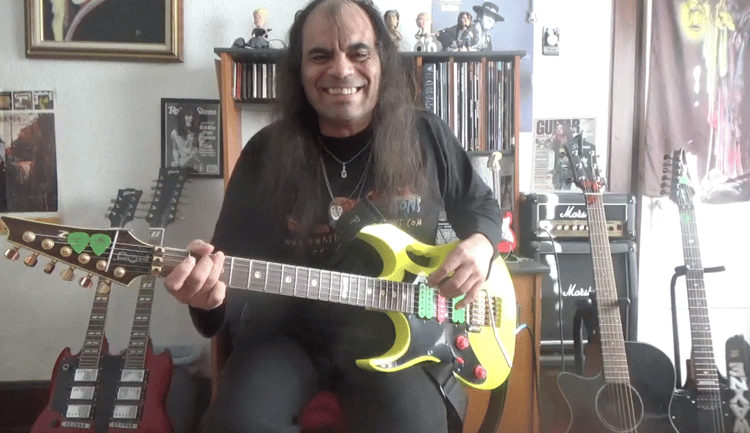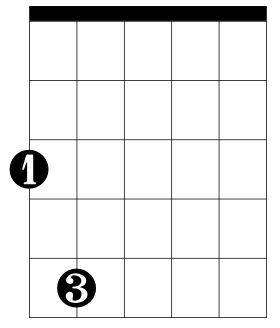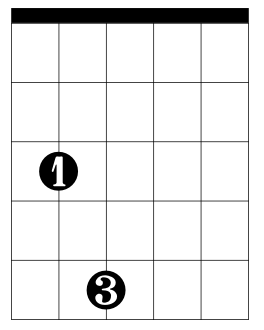In this lesson, we are going to learn how to form power chords and create rhythm. Once you have mastered your open chords or would like to take a break from them, you can proceed to work on your closed power chords. Once you get the open chords down you can focus on learning power chords & creating rhythm with them.

Closed power chords
Closed power chords are very much like your open power chords, it’s just that now you’re playing two strings where neither one is open. These are going to be the next chords in your vocabulary to learn because they are played with two fingers instead of just one. Your index finger and your ring finger. Or the pinky, if you prefer. Everyone plays a bit differently.
I recommend you use the first and third fingers, as this is more standard, and leave your pinky open to add chord embellishments later when you learn to form chords using three and four fingers. But for now, we’ll stick with two.
What’s great about these chords is two things.
*The chord shape always stays the same, no matter where you’re at on the fretboard.
*They allow you to move up and down the fretboard while keeping the same shape.
This allows you to unlock many mysteries of the guitar and rock guitar songs by playing chords of this type. Most rock songs ever written mostly use or have used these types of chords. So, make sure you take some time to learn how to form them and then learn how to move them around the fretboard.
When learning to form a power chord, you will need to stretch your fingers a bit. This chord shape is created by two fingers on two strings with a fret in between them. Once you learn this form of this chord, you will need to keep this shape when moving it around the fretboard. Be sure to watch the video lesson on how this is done.
Chord types are not the easiest to form as a beginner, but with a little consistent daily effort, you will begin to see some progress, and that is when the fun starts to happen. And as with all things, you must be patient and not give up. If you stick with it, your reward will be all the cool rock songs you’ll be able to play.
Watch the video lesson below
Reading power chords in chord charts
Watching me in the video lesson is fine. But it is very beneficial that you learn how to read them in the written language as well. Chord charts are a great place to start. This will give you a rounded education, a step up on most guitar players (most don’t read sheet music), and a more enhanced learning experience. Here are some examples of what power chords look like in chord chart format.



Chord charts represent the fretboard facing upward. The 6 vertical lines represent the 6 strings, and the horizontal lines indicate the nut and the first 5 frets. Here, we have a root 6 G power chord, a root 5 C power chord, and a root 4 E power chord. All played with the index and ring fingers. The 6th string will be on the left of the chord chart.
Creating rhythm with power chords
Accomplish this with proper timing and emotion. When creating a rhythm with power chords playing rock music you want to start with a simple 1 2 3 4 count. Because this is the most common timing of rock music.
Listen to bands like AC/DC. They use this timing in almost all their songs. You can tap your foot to the beat and follow along with the music. It is simple and effective. Then, once you get the initial timing of rock music down, you can create more complex rhythms. But in the beginning, keep it simple.
This creates the internal clock that all musicians must have and by focusing on improving your timing by counting (to yourself or out loud) you begin to develop this very important skill set. I can’t begin to tell you how many musicians I’ve met who have not developed proper timing.
Additional counts to use when creating rhythm
Here are a few more to experiment with:
Option 1: 1 & 2 & 3 & 4 &
Option 2: 1 2 & 3 4
Option 3: 1 2 3 & 4
Any of these examples will produce a nice rhythm, and if you work with them enough, you’ll begin to discover other ones you can create as well. Think of how creative you can be with just these four numbers. Look at our number system,m 0-9, and all the endless possibilities that we can come up with. Even though you’re just using four numbers, the concept is the same.
Once you work with these counts, you’ll begin to recognize familiar parts of songs you already know. So practice these rhythm counts while moving your power chords up, down, and around the guitar fretboard. That way, you will develop your internal clock and be on your way to becoming a good, solid rhythm guitar player. Which is vitally important.
Start moving
Moving your power chords is essential to learn. Make sure to lift your fingers slightly off the fretboard, but keep them on the strings. Play only the two strings that the chord is made of. For the rest of the strings, try to mute with your fretboard hand. This will keep unplayed strings from vibrating and causing unwanted sounds. It will allow you to produce a cleaner, richer guitar tone.
Use a solid step-by-step system
Certain techniques are associated with playing rhythm guitar that you will need to master. This takes time. But with the proper training, it won’t take as much time as you think. That is, if you use a system of learning. That is why I authored and self-published
Rock Guitar 101

Rock Guitar 101 is a simple step-by-step method book that will enhance your playing and understanding of rock guitar. It has pictures, diagrams, and easy-to-understand music notation. You will be having fun playing in no time. Once you learn these concepts and techniques, you will learn how to set them up and get the best out of them.
You’ll also discover how to develop practice habits, basic music theory, and more. All without previous musical knowledge or ability. This can be very beneficial when getting started. If this is you or anyone you know, order this book today on Amazon and get started. You’ll be having fun playing guitar in no time.
Additional training available
If you need additional training, I also offer the service of private guitar instruction. This is a great way to get a leg up on your guitar playing. They can teach you insider secrets and allow you to progress faster. Which will allow you to get your desired result sooner. Just contact me at my website.
Thank you for your time, and keep up the good work.
Until our next lesson, take care.
Sincerely, Dwayne Jenkins.


